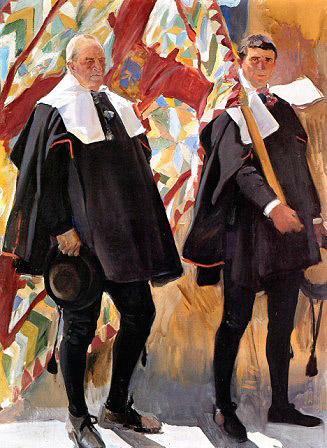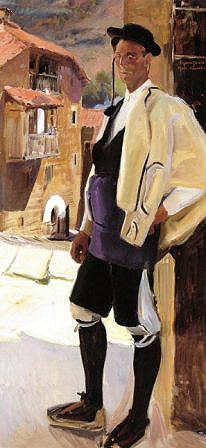September 3, 2016
About cultural heritage in the Roncal Valley
Types and landscapes: in the footsteps of Sorolla in the Roncal Valley
Mr. Javier Azanza López
Chair of Heritage and Art of Navarre
In the last days of August 1912, the local and national press echoed the presence in Roncal of the "eminent Valencian painter Joaquín Sorolla"(El Eco de Navarra, August 28, 1912), who, taking advantage of his summer vacation in San Sebastián, came to the Navarrese valley with the intention of "transferring to canvas with his usual mastery the beauties of our landscape"(Diario de Navarra, August 28, 1912, p. 3).
The origin of the stay in Navarre in 1912 of the greatest exponent of Luminism (topic to which authors such as Covadonga Pitarch, Fernando Hualde or Miguel Javier Guelbenzu have approached) is to be found in the commission that the founder of the Hispanic Society of New York, Archer Milton Huntington, a friend staff of the Valencian painter, had given him a year earlier to decorate the institution's Library Services with fourteen large panels showing the different regions of Spain and which would serve as presentation of the country to the American public. Having discarded the promoter's initial idea of recreating the most transcendental episodes of Spanish history, Sorolla finally approached the Vision of Spain in New York from the perspective of popular scenes, with special emphasis on costumes.
Between 1911 and 1919 (especially in 1912, the year of his visit to Navarra), Sorolla traveled throughout Spain with the goal to find themes for his panels, which were markedly costumbrist and sometimes ethnographic in nature. Very much in line with the intellectual ideas of the time (Generation of '98, Institución Libre de teaching), he turned his gaze towards the rural or picturesque world, as he called it, rejecting the more modern images of the modern life that was already typical of the big cities of our country; in fact, such a choice took place at a time when this traditional life was beginning to disappear rapidly, displaced by the inevitable globalization that industrialization was imposing.
The final result was a set of fourteen panels, 3 meters high by 70 meters long, painted in oil, with a very staff interpretation of the varied Spanish geographical reality; pictures in which men and women from different Spanish provinces are represented, through which the painter tries to transmit not only the physical features of each region, but also their typical costumes, their jobs, customs and folklore. When it was completed in 1919, its transfer to New York was delayed by the painter's illness and death in 1923, so that the Hispanic Society's Sorolla conference room was not inaugurated until January 1926.
Why did Sorolla choose Roncal as one of the places to capture his Vision of Spain? Undoubtedly, his interest in costumes was a major reason, since the alderman's or mayor's costume of Roncal is one of the oldest in the country. Nor should we rule out the committee of his friend and countryman Mariano Benlliure, who in 1901 had traveled to the town of Navarre to install Gayarre's mausoleum in its cemetery.
Accompanied by his friends the painter Adolfo Marín, the American painter Jane "Juanita" Peterson and the photographer Francisco de las Heras, group stayed at the house of Gregorio Garjón, Gayarre's cousin ("a very attentive gentleman and his food and bed are admirable", he would say of him). As soon as he settled in, he began to work (the correspondence with his wife Clotilde provides a great deal of information about his activity during these days), and at the same time he got to know and even participated in some of the local customs, such as the pelota game or the regional costume dance.
During his stay in Roncal, Sorolla painted three portraits, two landscapes, and numerous sketches. These are the portraits Tipos del Roncal (private collection), Tipos del Roncal (Sorolla Museum) and subject del Roncal (Sorolla Museum), in which it is possible to recognize the models who posed for the painter (Benita Daspa, Raimunda Monzón, José Sanz, Eugenio Gárate). Along with the portraits, the Valencian paints Valle de Roncal (Museo Sorolla) and Pueblo de Roncal (Museo Sorolla), in which he captures the nuances of the landscape and the Roncal people with quick and light sketches; both will also serve as a backdrop for his paintings of types.

Types of Roncal, 1912
(Private collection)

Types of Roncal, 1912
(Sorolla Museum)

subject of Roncal, 1912
(Sorolla Museum)
With all this material, in addition to the typical costumes he acquired during his stay in Jaca in 1914, he composed the painting Navarre. El Concejo de Roncal, destined for the Hispanic Society. sample the moment in which the authorities of Roncal, accompanied by the ensign of the Valley, arrive at the Shrine of Our Lady of Fair Love of the Virgen del Castillo (its architecture idealized with a tower, also the protagonist of some programs of study), which could be either a meeting of the board of the Valley (there are seven aldermen, as many as villages in the Valley, although in previous sketches a greater number of characters appears issue ), or a pilgrimage to the Virgen del Castillo. Be that as it may, we cannot overlook the fact that this is the only painting of the whole set destined for the New York institution in which Sorolla depicts an authority, undoubtedly reflecting the importance of the Roncal council. To the right of the leaders, seated or standing, are six women dressed in different typical costumes.

Navarre. The Council of Roncal, 1914
(Hispanic Society. New York)
"After having spent a few days in this valley, yesterday the illustrious painter Joaquín Sorolla left for Biarritz... he has painted types of the valley in Isaba and Roncal"(Diario de Navarra, September 1, 1912, p. 2). It does not seem that he returned to the Navarre valley, although some authors defend the possibility of a second visit two years later. As a testimony of his stay in Roncal, a card of visit: "Joaquín Sorolla y Bastida. Pº Martínez Campos, 13 y 15", with a fold in its lower left corner, a testimony perhaps -according to the codes of the time- of his gratitude for the attention and hospitality received during the days he stayed in Navarre? The Roncaleses that he captured in his paintings have the answer.
